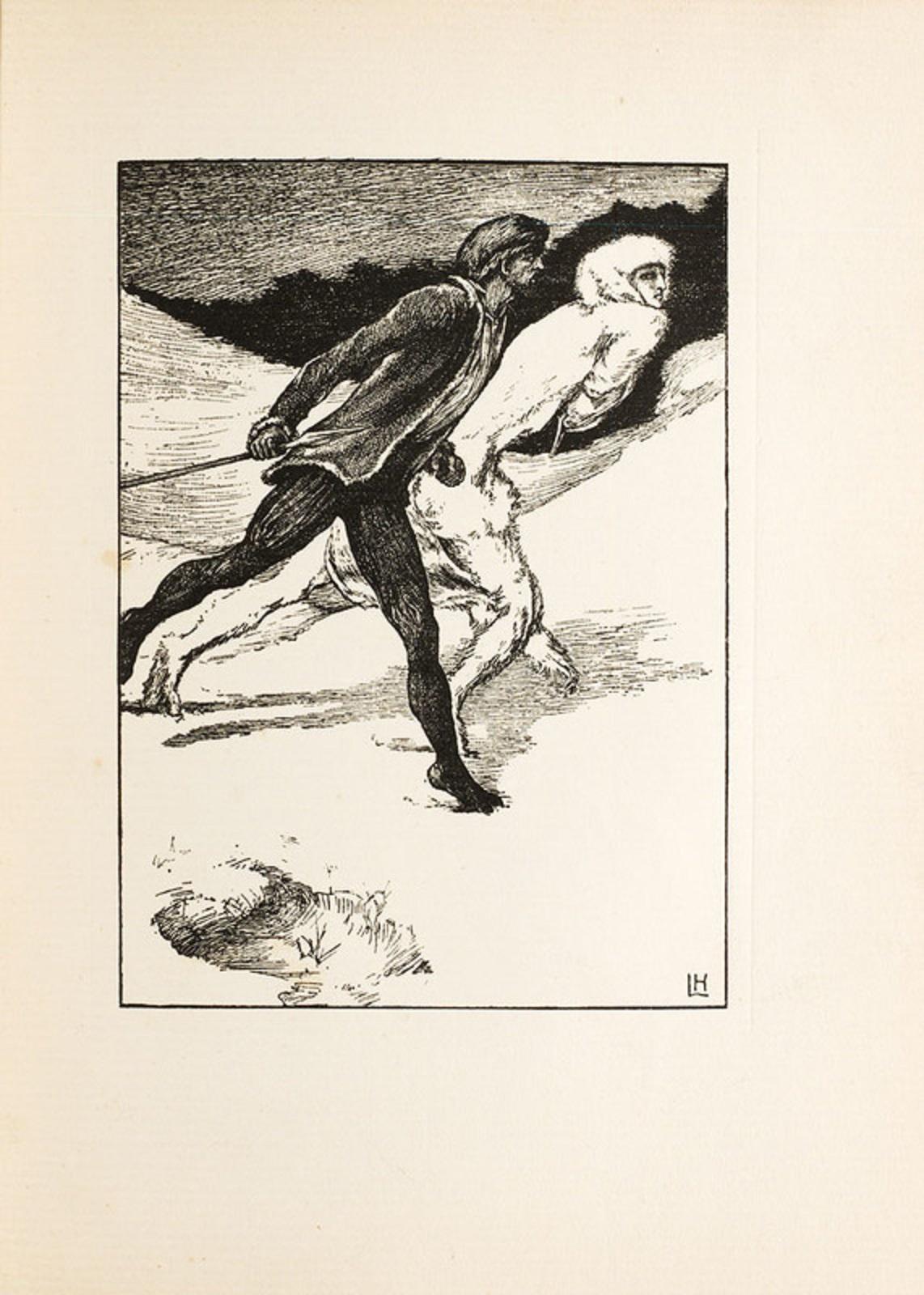In 1896, Clemence Housman’s wood-cut engraving illustration, “The Race” was published in her fantasy novel, The Were-Wolf, using a relief printing technique. The full-page engraving was based on her brother Laurence Housman’s original design, facing page 80 of the book. The Were-Wolf was first published as a short story in Atalanta: A Magazine for Girls in 1890, before later being published with John Lane at The Bodley Head nearly a decade later. This illustration features a pivotal moment of tension when the titular were-wolf character, White Fell, is being chased by Christian in the winter landscape following his accusations that she murdered his family. The characteristic visual style elements of the Housman siblings’ previous artistic endeavours are on display here, featuring intricate detail work and fluid lines, taking after the style popularized by the Pre-Raphaelite Brotherhood
The compositional elements of the piece feature both the characters in profile but with Christian slightly behind with his spear in hand. White fell is covered in a white wolf pelt, while Christian is dressed in darker outdoor garb. White Fell’s depiction within this illustration is decidedly gender ambiguous, as her entire body is cloaked by the wolf pelt she wears. Her design does not quite lean into the femme fatale narrative that was otherwise crafted with Clemence Housman’s work, which speaks towards the commentary towards identity hybridity and challenging of pre-conceived notions of gender that the siblings were encouraging throughout their literary and artistic careers. Both of the siblings were supporters of the women’s rights movements throughout the late nineteenth-century.
The lower-half of White Fell’s body is visually transforming into her lupine form, as can be seen with her wolf tail and canid legs. This is the moment before she transitions into her beast form. These design choices provide several allusions about the innate nature of White Fell’s character, as well as potentially connecting towards the depiction of wolves in several mythologies. The iconographic choices incorporated in the illustration allude towards the Scandinavian location of the novel. Wolf-clad individuals were synonymous with Norse mythology, specifically that of the Úlfhéðnar. These male wolf-warriors wore the pelt of wolves into battle and served as Odin’s combatants. There is also a possibility that White Fell’s design purposefully bears resemblance to the Nattmara, female demonic entities within Norse mythology associated with were-wolves or banshees. These creatures typically preyed upon villages, similarly to how Christian accuses White Fell of her crimes. These artistic choices may have been done to show the hybridity of her nature, as she comes to the village as a hunter dressed in furs when she is actually the predator who preys upon the village. This may have served as an interpretation of the hybridity of women and their identity, emphasizing how the nature of women can be torn between monstrosity and seduction.
Principal Sources:
Janzen Kooistra, Lorraine. “Doubles and Doubling Back: On (Re)Reading Clemence Housman’s The Were-Wolf.” Victorian Review, Victorian Review: An Interdisciplinary Journal of Victorian Studies, 2 July 2019, victorianreview.org/?p=1723.
Kaur Natt, Harpreet. “Textual History and Contemporary Reception of Clemence Housman's ‘The Were-Wolf.’” COVE, 15 May 2018, editions.covecollective.org/edition/were-wolf/textual-history-and-contemporary-reception-clemence-housman%E2%80%99s-were-wolf.
Suparti, Erni. “Scandinavian Myths and Grimm's Tales in Clemence Housman's The Were-Wolf.” COVE, 15 May 2018, editions.covecollective.org/edition/were-wolf/scandinavian-myths-and-grimms-tales-clemence-housmans-were-wolf.
Tuczay, Christa Agnes. "Into the Wild—Old Norse Stories of Animal Men." Werewolf Histories, Palgrave Macmillan, London, 2015. pp. 61-81.


